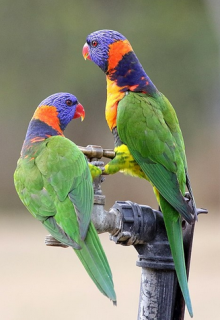Red-collared Lorikeet |
|
|
Species Profile
Genus: Trichoglossus | Species: rubritorquis
Size:
26 cm (10in)
Weight:
103–140g (3.5-5.0 oz)
Subspecies including nominate:
one
Colour Adult:
Both adults violet/blue head with lilac/blue streaks on face; throat and side of nape blackish; collar orange/red; yellow/orange breast without barring; dark green abdomen; green/yellow thighs to undertail coverts; green upperparts and tail; orange underwing coverts; yellow, wide band under the wing. Bill orange/red. Eye dark orange.
Colour Juvenile:
As in adults.
Call:
Repeated notes, sharp, rolling while in flight. Shrill chattering while feeding. Soft notes at rest.
Listen NowVideo Links:
Video 1More Information:
Content Sources:
BirdLife International
Cornell Lab of Ornithology/Birds of the World
xeno-canto Red-collared Lorikeet, Anderson, Marc, XC172143
Parrots in Aviculture, Low, 1992.
Lexicon of Parrots, Thomas Arndt.
Species Care
Captive Status:
Rare outside of Australia.
Longevity:
20 yrs in the wild, 15-25 yrs in captivity.
Housing:
Enclosure with drain in floor, or suspended cage over tiled or concrete floor.
Diet:
Nectar - a commercial type specially formulated for small species or a mix of baby cereal (lactose-free) and honey, malt extract or molasses, mixed with filtered water, made fresh once or twice daily, making up at least 40 percent of the diet; vegetables and fruit especially apple, pear, orange, cactus fruits and bananas, and one or more daily of: carrot, fresh corn, green leaves; plus dried figs soaked in water for a few hours, spray millet and a small amount of soaked or sprouted sunflower seed and small amount of canary seed.
Enrichment:
Loves bathing, hanging toys, puzzle/foraging toys, foot toys, ladders, swings, socializing; noisy toys (bells, squeakers), bird safe chewables (vegetable tanned leather, safe woods).
Nest Box Size:
L-shaped box, 51cm x 36cm (20 x 14 in).
Clutch Size:
2 to 3
Incubation Time:
23-25 days
Fledging Age:
8-9 weeks
Hatch Weight:
5g (0.2 oz)
Peak Weight:
Not recorded.
Weaning Weight:
Not recorded.
Specialist Club:
Species Wild Status
World Population:
Unknown, decreasing.
IUCN Red List Status:
Least Concern
CITES Listing:
Appendix II
Threat Summary:
Not globally threatened. One of the more common parrots in its range.
Range:
Northern Australia.
Habitat:
Most common in lowlands but found up to 2400m (7872 ft). Wide variety of areas including settlements, forest, coconut plantations, savanna, Eucalyptus stands and mangroves.
Wild Diet:
Feeds mainly on nectar, fruit and flowers of Eucalyptus bleeseri, E. miniata, E. polycarpa, E. tetrodonta, Melaleuca viridiflora and Grevillea pteridifolia; in addition, Pandanus spiralis, Bombax ceiba, Terminalia grandiflora, Planchonia careya, Amyema sp., Eucalyptus clavigera, E. confertiflora, E. latifolia, E. miniata, E. porrecta, Melaleuca symphyocarpa and Xanthostemon paradoxus. Also takes insects.
Ecology and Behaviour:
Found in mixed flocks with other parrots; in small noisy groups. Nomadic, as they are dependent on flowering trees. Roosts communally in groups of hundreds of birds. Will also roost and nest on the ground on some of the predator-free islands. Displays frequently.
Clutch and Egg Size:
2 to 3 ovate eggs, 27.0 x 22.5mm (1 x 0.9 in).
Breeding Season:
Breeding recorded most months in N Australia.
Members Only Resources
Please log-in now to find more research, resources and tools.
Not a Member?
Find more great information:
Gain exclusive access to 600+ pages of additional research, seminars and podcasts, specialists to ask your toughest questions, and dozens of other fun resources - when you become a WPT member.
Join Today >>

































